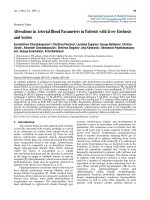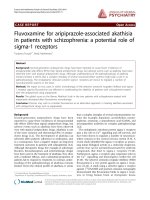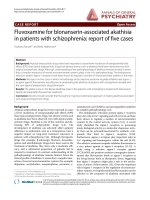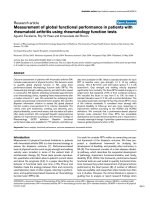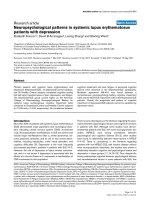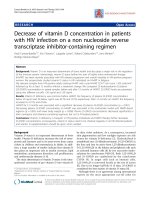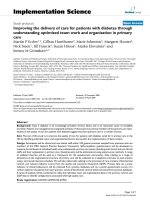Báo cáo y học: "How natural light affects critically ill patients with subarachnoid hemorrhage" ppsx
Bạn đang xem bản rút gọn của tài liệu. Xem và tải ngay bản đầy đủ của tài liệu tại đây (109.22 KB, 2 trang )
Wunsch and colleagues analyzed the eff ect of window
rooms on critically ill patients admitted to the ICU with
subarachnoid hemorrhage, and concluded that the
presence of a window in an ICU room did not improve
their outcomes [1]. We commend the attempt to asso-
ciate natural light with improved outcomes for hospital-
ized patients, but we have some concern as regards the
data analysis and interpretation.
e Hunt–Hess grade has been well accepted to
correlate with subarachnoid hemorrhage mortality [2,3].
Although the authors performed subgroup analysis in
patients with a Hunt–Hess score of I to III during the
ICU stay, further stratifi ed analyses according to the
Hunt–Hess score still are needed. is analysis may
exclude disease severity as a confounding factor, espe-
cially when natural light does not aff ect the outcomes of
critically ill patients as markedly as does disease severity.
We would therefore like to ask whether there is a
diff erence regard ing disease outcomes in subgroups of
patients with diff erent Hunt–Hess scores. We have noted
that patients with both aneurysmal and spontaneous
nonaneurysmal subarachnoid hemorrhage were
included. Since the Hunt–Hess score was initially
designed for cerebral aneurisms [4], we are also interested
to know whether the authors performed subgroup
analyses based on aneurys mal and nonaneurysmal
etiologies.
e potential importance of natural light for quality
care of critically ill patients should be emphasized,
especially in terms of minimizing circadian rhythm
disruptions [5]. Moreover, as recommended by the
Society of Critical Care Medicine, light in the ICU should
be designed to be adjustable [5]. is factor seems to be
crucial for studies aiming to explore the role of natural
light in improving the outcomes of critically ill patients.
Otherwise the actual eff ects of natural light might be
signifi cantly weakened by the 24-hour glaring artifi cial
light in an ICU.
© 2010 BioMed Central Ltd
How natural light a ects critically ill patients with
subarachnoid hemorrhage
Hongliang Zhang
1,2
* and Jiang Wu
1
See related research by Wunsch et al., />LETTER
Authors’ response
Hannah Wunsch, Hayley Gershengorn, Stephan A Mayer and Jan Claassen
We appreciate the thoughtful comments and queries of
Zhang and Wu. We agree that there are many potential
analyses that might result in identifi cation of benefi t (or
harm) in specifi c subgroups of patients. However, we
limited our analyses to the subgroups we had chosen a
priori due to the size of the cohort [1]. In particular, we
chose not to stratify patients into smaller subgroups,
such as individual Hunt–Hess scores, because the
resulting groups would then be inadequately powered to
identify reasonable diff erences in outcomes. We appre-
ciate the suggestion regarding stratifi cation by
aneurys mal and nonaneurysmal etiology, and in post hoc
analyses we did not fi nd any diff erence in our primary
outcomes of the modifi ed Rankin Scale at hospital
discharge, at 3months and at 1 year.
e question of the eff ect of light on critically ill
patients is complex. We are clearly only at the beginning
of exploratory analyses both to identify appropriate
patient groups for study and to understand the mecha-
nisms of action of light in the human body during critical
illness. Current analyses are limited by available data and
we hope that future studies may allow for prospective
design, including randomized trials, to examine this
important issue.
Abbreviations
ICU, intensive care unit.
Competing interests
The authors declare that they have no competing interests.
*Correspondence:
1
Department of Neurology, First Hospital of Jilin University, Jilin University, Xinmin
Street 71#, 130021 Changchun, China
Full list of author information is available at the end of the article
Zhang and Wu Critical Care 2011, 15:423
/>© 2011 BioMed Central Ltd
Author details
1
Department of Neurology, First Hospital of Jilin University, Jilin University,
Xinmin Street 71#, 130021 Changchun, China.
2
NVS, Karolinska Institute,
Novum, plan 5, Huddinge, SE 141 86, Stockholm, Sweden.
Published: 10 May 2011
References
1. Wunsch H, Gershengorn H, Mayer SA, Claassen J: The e ect of window
rooms on critically ill patients with subarachnoid hemorrhage admitted to
intensive care. Crit Care 2011, 15:R81.
2. Rosen DS, Macdonald RL: Subarachnoid hemorrhage grading scales:
asystematic review. Neurocrit Care 2005, 2:110-118.
3. Hunt WE, Kosnik EJ: Timing and perioperative care in intracranial aneurysm
surgery. Clin Neurosurg 1974, 21:79-89.
4. Hunt WE, Hess RM: Surgical risk as related to time of intervention in the
repair of intracranial aneurysms. J Neurosurg 1968, 28:14-20.
5. Guidelines for intensive care unit design. Guidelines/Practice Parameters
Committee of the American College of Critical Care Medicine, Society of
Critical Care Medicine. Crit Care Med 1995, 23:582-588.
doi:10.1186/cc10146
Cite this article as: Zhang H, Wu J: How natural light a ects critically ill
patients with subarachnoid hemorrhage. Critical Care 2011, 15:423.
Zhang and Wu Critical Care 2011, 15:423
/>Page 2 of 2
